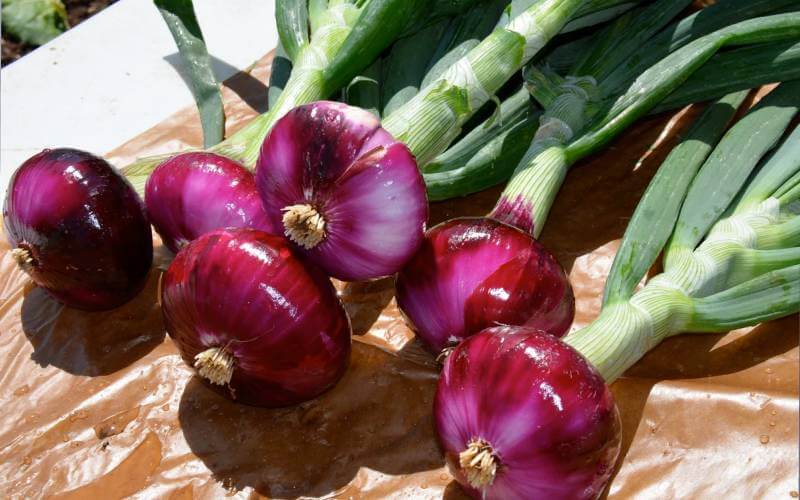
Planting red Creole onions is a rewarding endeavor that can provide you with a bountiful harvest of vibrant red onions with a sweet flavor. To ensure a successful onion crop, it is essential to follow proper planting techniques. In this step-by-step guide, we will walk you through the process of planting red Creole onions, providing expert advice and friendly instructions to help you achieve optimal results.
Step 1: Prepare the Soil
- Choose a well-drained location with fertile soil for planting red Creole onions.
- Clear the area of weeds, rocks, and debris.
- Loosen the soil using a garden fork or tiller to a depth of 10-15 centimeters.
Step 2: Amend the Soil
- Test the soil’s pH level using a soil testing kit and ensure it falls within the range of 6.0 to 7.5, slightly acidic to neutral.
- If necessary, amend the soil by adding organic matter such as compost or well-rotted manure to improve its fertility and structure.
Step 3: Select Quality Onion Sets or Seeds
- Choose high-quality red Creole onion sets or seeds from a reputable source.
- Onion sets are small, dormant bulbs, while seeds are tiny black or brown specks.
- Ensure that the onion sets or seeds are disease-free and viable.
Step 4: Determine Planting Time
- Consider the climate and growing season of your region to determine the best time for planting red Creole onions.
- These onions are typically planted during the cool season, allowing them to establish before the onset of hot weather.
Step 5: Planting Onion Sets
- Dig shallow furrows or trenches in the prepared soil, with a spacing of 10-15 centimeters between rows.
- Place the onion sets gently into the furrows, ensuring that the pointed end faces upward.
- Space the sets approximately 5-8 centimeters apart within the row.
Step 6: Planting Onion Seeds
- Create furrows or drills in the soil, approximately 1 centimeter deep.
- Sow the onion seeds thinly along the furrows, ensuring even distribution.
- Cover the seeds with a thin layer of soil and gently firm it down.
Step 7: Watering
- After planting, water the onion sets or seeds thoroughly to ensure proper moisture penetration.
- Maintain consistent moisture levels, providing approximately 2.5 centimeters of water per week.
- Be cautious not to overwater, as excessive moisture can lead to rotting or fungal diseases.
Step 8: Weed Control
- Regularly inspect the onion bed for weeds and remove them promptly.
- Weed diligently during the early stages of growth to prevent competition for nutrients and water.
Step 9: Fertilization
- Apply a balanced fertilizer, such as a 10-10-10 NPK formulation, once the onions have sprouted and established.
- Follow the manufacturer’s instructions regarding the application rate and frequency.
- Avoid excessive nitrogen fertilization, as it can promote leafy growth at the expense of bulb development.
Step 10: Thinning
- Once the onion plants have reached a height of 10-15 centimeters, thin them to ensure adequate spacing.
- Remove the weaker or overcrowded plants, leaving the healthiest ones spaced approximately 10-15 centimeters apart.
Step 11: Mulching
- Apply a layer of organic mulch, such as straw or chopped leaves, around the onion plants.
- Mulching helps retain soil moisture, suppresses weed growth, and regulates soil temperature.
Step 12: Continued Care
- Regularly monitor the onions for signs of pests or diseases.
- Control pests using appropriate organic or chemical measures if necessary.
- Provide sufficient water, especially during dry periods, and ensure consistent moisture levels.
Step 13: Harvesting
- Red Creole onions are typically ready for harvest when the tops (leaves) start to yellow and flop over.
- Carefully loosen the soil around the bulbs using a garden fork, taking care not to damage them.
- Lift the bulbs and allow them to dry in a well-ventilated area for a few weeks.
Step 14: Storage
- After the onions have dried, remove any remaining foliage and store them in a cool, dry, and well-ventilated place.
- Use mesh bags or crates to promote proper airflow and prevent moisture buildup.
Planting red Creole onions can be a fulfilling and fruitful experience when following a step-by-step guide. By preparing the soil, selecting quality onion sets or seeds, providing proper care throughout the growing season, and harvesting at the right time, you can enjoy a successful harvest of vibrant red onions. Remember to monitor the plants regularly, address any issues promptly, and adapt the instructions based on your local conditions. Happy planting and enjoy your homegrown red Creole onions!
Stay updated with the latest farming tips and agriculture industry news from Africa by subscribing to our newsletter. Don’t miss out on valuable insights and updates. Follow us on Twitter, LinkedIn, and Facebook to join our farming community and stay connected with us.



















